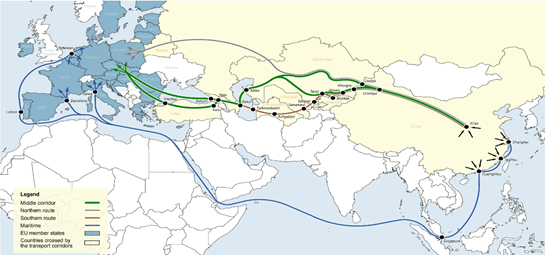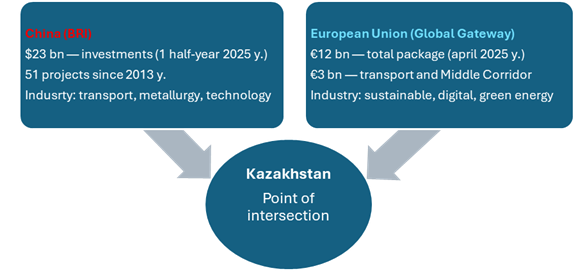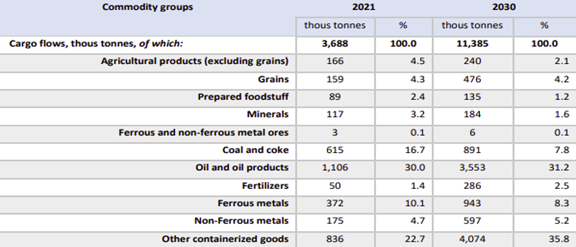With the New Silk Road Network gathering soon in Almaty, we are proud to feature an article from our Consulting and Educational Partner, Trans Caspian Cargo. Their perspective highlights how transport, infrastructure, and human capital are transforming Kazakhstan's strategic role in global supply chains.
Abstract
Kazakhstan is entering a new stage in the development of transport logistics: logistics, transport, and infrastructure are no longer auxiliary sectors but are becoming key drivers of national competitiveness. Investments from China and the EU in the Middle Corridor are creating a unique window of opportunity for the oil and gas industry, investors, and operators. The growth of container transportation, export diversification, and the development of multimodal routes open prospects for accelerated return on investment and reduced operational risks. Over the next five years, logistics will determine Kazakhstan’s strategic position in global supply chains.
Challenges of the New Era: What the President Said and What We Hear
The Address of President Kassym-Jomart Tokayev on September 8, 2025, marked a turning point: Kazakhstan can no longer remain a passive link in global supply chains. The country must rely on three pillars: resilience, human capital, and digitalisation. Special emphasis has been placed on logistics and transport, which are now considered key drivers of competitiveness and attractive investment. The President emphasised: “We need to make full use of the emerging opportunities and become a transport and transit hub of truly global significance” (Akorda, 2025).
Western Kazakhstan: Hub of Oil and Logistics
Western Kazakhstan remains the centre of the oil and gas industry. Tengizchevroil (TCO), NCOC, KPO, and EPC contractors are concentrated here, along with the ports of Aktau and Kuryk. This region is not just about extraction and export, but also a node of transport risks. Every disruption in logistics affects project timelines and penalties. For investors, this means that investments in infrastructure (terminals, railway hubs, container capacities) are directly linked to the financial outcomes of oil and gas projects.

Figure 1. The Middle Corridor among Europe–Asia routes (Source: World Bank, 2023. Middle Trade and Transport Corridor. Washington, DC).
East and West: Investments of China and the EU
Today, Kazakhstan is experiencing a moment that defines the future of the country. In the past, it was called a “landlocked country” — a nation without access to the sea. But today it is becoming a “land-linked country” — a nation connecting the largest markets and civilisations. Why? Because two key initiatives of the 21st century intersect precisely here:
· from the East — China’s Belt and Road Initiative (BRI),
· from the West — the European Union’s Global Gateway initiative.
Kazakhstan is becoming a strategic hub of Eurasia. In the first half of 2025, Kazakhstan became the leader in attracting Chinese investments under the Belt and Road Initiative — about USD 23 billion (Forbes, 2025). At the EU–Central Asia Summit in April 2025, the European Union announced a Global Gateway investment package worth EUR 12 billion, of which around EUR 3 billion was allocated to transport infrastructure (European Council, 2025). Thus, China builds speed and railways, while Europe brings sustainability and digitalisation.

Figure 2. Investments in Kazakhstan from China and the European Union in 2025.
China focuses on speed and infrastructure, while the EU emphasises sustainability and digitalisation — making Kazakhstan the point of intersection of strategic interests.
The Middle Corridor: Structure and Economics
According to World Bank estimates, by 2030, cargo flows through the Middle Corridor will triple, reaching 11 million tons. Container traffic is expected to grow to 300,000 TEU. This opens new prospects for economic diversification. The table below shows how the cargo structure is changing.
Table 1. Commodity structure of exports through the Middle Corridor (2021–2030).
 Resource: World Bank, 2023. Middle Trade and Transport Corridor. Washington, DC.
Resource: World Bank, 2023. Middle Trade and Transport Corridor. Washington, DC.
The heatmap clearly demonstrates a significant increase in containerised cargo (almost fivefold), as well as growth in petroleum products and metals, confirming the diversification of exports.
Human Capital as Infrastructure
However, infrastructure is not only about roads and terminals — it is also about people. This is where the most serious shortage has been identified. A study conducted by the TCC team among more than 30 companies and universities in the region revealed results. Only 22% of companies believe that the training level of logisticians meets the requirements of modern business. More than 32% reported that graduates are unprepared for real-world tasks: they do not know Incoterms, cannot handle ADR-class cargoes, and have limited knowledge of sanctions regulations and digital tools (TransCaspian Cargo Proprietary Research, 2025). These figures show that the human capital issue in logistics is no less acute than the shortage of infrastructure. This is why TransCaspian Cargo, through its TCC Academy, is launching next-generation practical programs: EPC project management, digital logistics, and ESG approaches. For investors, this means reduced operational risks; for managers, it means improved project management quality and cost savings.
Education as Infrastructure: Not Walls, but People
Today, infrastructure is not only about roads and railcars. It is also an infrastructure of meaning, knowledge, and competencies. What Kazakhstan needs is not just the rails for cargo, but the power capable of managing the routes. TCC views education as a strategic infrastructure, without which logistics cannot be sustainable. That is why TCC proposes to:
Conclusion: A Window of Opportunity
Kazakhstan is no longer a “locked continent.” In the next five years, the country has a window of opportunity: for investors — projects in terminals, containerization, and digital services; for oil and gas companies — reduced risks and lower costs; for the state — transformation into a regional hub. Logistics is becoming part of national competitiveness.
The Middle Corridor is not just a route, but a geo-economic project that will define Kazakhstan’s competitiveness for decades. The question is stark: either the country seizes this chance, or it yields leadership to competitors.
Learn more about TransCaspian Cargo
References:
World Bank. (2023). Middle Trade and Transport Corridor: Policies and Investments to Triple Freight Volumes and Halve Travel Time by 2030. Washington, DC: The World Bank. Retrieved from https://openknowledge.worldbank.org/handle/10986/39871
Akorda. (2025, September 8). Послание Президента Касым-Жомарта Токаева народу Казахстана. Retrieved from https://www.akorda.kz
Forbes. (2025, June 10). Казахстан стал лидером по китайским инвестициям в рамках BRI. Forbes Kazakhstan. Retrieved from https://forbes.kz
European Council. (2025, April 4). Joint press release following the first EU–Central Asia summit. Retrieved from https://www.consilium.europa.eu/en/press/press-releases/2025/04/04/joint-press-release-following-the-first-eu-central-asia-summit/